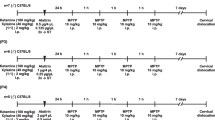Abstract
l-2-Chloropropionic acid (L-CPA) produces selective necrosis to the granule cell layer of the rat cerebellum. As part of a study to understand the mechanism of selective toxicity we have investigated the metabolism and disposition of [2-14C]L-CPA in the rat, with particular emphasis on the brain. Following a single oral non-toxic dose of 250 mg/kg or a neurotoxic dose of 750 mg/kg or 250 mg/kg per day for 3 days, L-CPA is very rapidly absorbed from the gastrointestinal tract into the blood stream. Peak plasma concentrations of 2 mM (250 mg/kg) and 6 mM (750 mg/kg) L-CPA occurred within 1 h of dosing, and the compound was readily cleared from the plasma with a half-life of 2.6 h. The only metabolite detected in the plasma was 2-S-cysteinylpropanoic acid, presumably derived from the glutathione conjugate. About 60% of the dose is excreted in the urine in the first 24 h as unchanged L-CPA, with a smaller amount excreted as the mercapturate, 2-S-N-acetylcysteinylpropanoic acid. Little radiolabel from L-CPA is excreted in the faeces; however, ∼18% of a 250 mg/kg dose of L-CPA is eliminated as carbon dioxide. The radiolabel from [2-14C]L-CPA present in the cerebellum, forebrain and liver at all time intervals examined was L-CPA. There was some indication of retention of L-CPA in the brain relative to the plasma with a small but consistently higher concentration found in the cerebellum. Whole body autoradiography studies indicated some selective retention of radiolabel in the cerebellum after the third dose of 250 mg/kg [2-14C]L-CPA. Our findings indicate that the initial insult to the cerebellum following L-CPA administration is probably due to the parent compound however, the prolonged presence of 2-S-cysteinylpropanoic acid in the plasma and concomitant depletion of glutathione in the cerebellum may also play a role in the toxicity. The relevance of the slightly greater retention of L-CPA in the cerebellum to the selective neurotoxicity of L-CPA requires further study.
Similar content being viewed by others
Author information
Authors and Affiliations
Additional information
Received: 25 March 1997 / Accepted: 21 May 1997
Rights and permissions
About this article
Cite this article
Wyatt, I., Farnworth, M., Gyte, A. et al. l-2-Chloropropionic acid metabolism and disposition in male rats: relevance to cerebellar injury. Arch Toxicol 71, 668–676 (1997). https://doi.org/10.1007/s002040050443
Issue Date:
DOI: https://doi.org/10.1007/s002040050443




